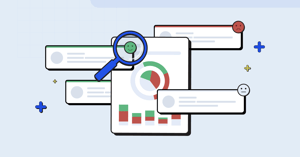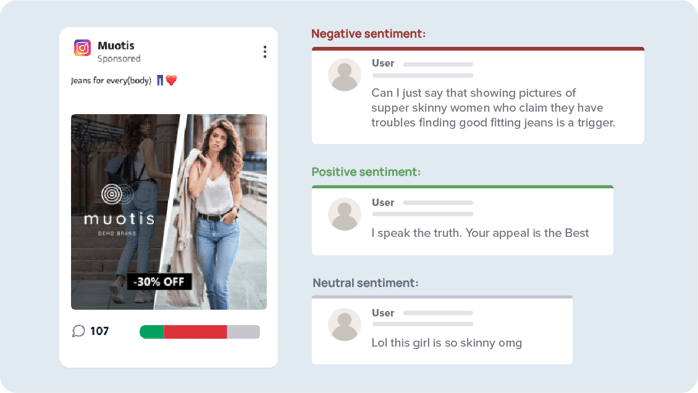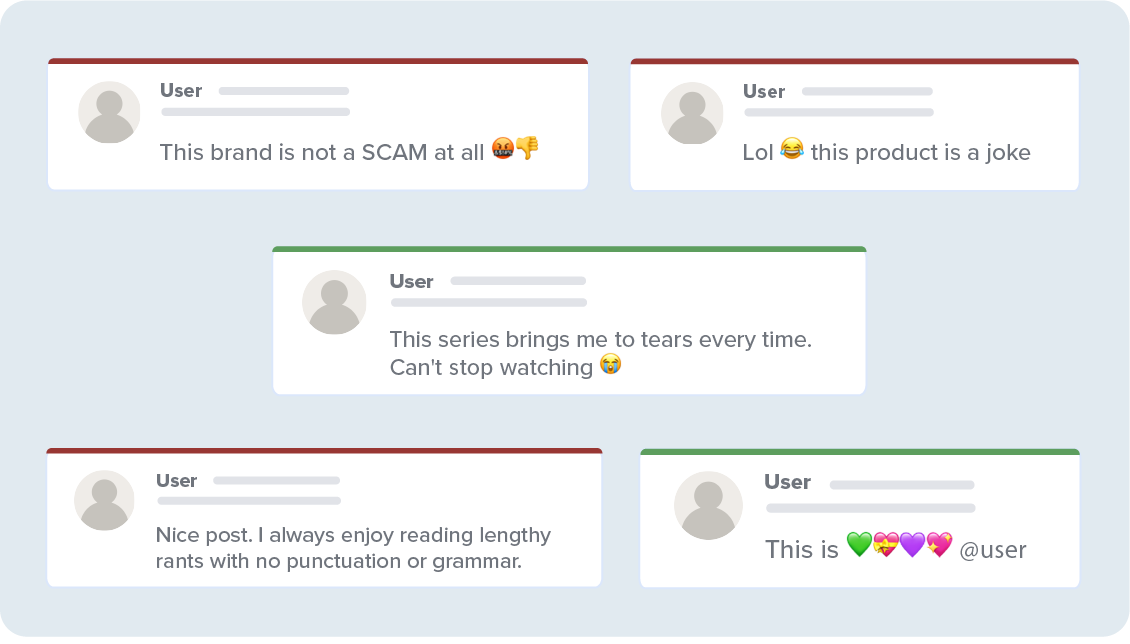
Learn All About Social Media Sentiment Analysis
What if you could tap into the emotions and opinions of your target audience on social media? And what if you could use these insights to create more engaging content or uncover areas of improvement? Well, all this is actually within reach with the power of social media sentiment analysis.
Social media sentiment analysis is a process that helps you analyze people's feelings and attitudes and determine if they are positive, negative, or neutral toward your brand, product, service, or topic. In this article, you’ll learn more about what social media sentiment analysis is and how it can help you optimize your social media marketing strategies.
- What is sentiment analysis on social media?
- Sentiment analysis requires an in-depth understanding of social media language
- What is the fundamental purpose of sentiment analysis on social media?
- Social media sentiment analysis helps you truly understand your audience
- Make sure to get an accurate sentiment analysis across all social media platforms
What is sentiment analysis on social media?
Sentiment analysis (also referred to as opinion mining) is a method that helps you understand people's perceptions, opinions, attitudes, and emotions. In social media, sentiment analysis is mainly used by companies and marketers to know how their target audience feels and thinks about their brand and business.
And what does sentiment analysis look like in practice? In short, you evaluate whether an opinion expressed through language is positive or negative (or neutral if an opinion is not explicit). This is helpful when you want an overall picture of people's thoughts and feelings about a subject or topic. You can, for example, use insights from the analysis to understand how your target audience perceives an ad or campaign.

Sentiment analysis requires an in-depth understanding of social media language
Sentiment analysis has proved to be an efficient method to understand customer perception and bring additional insights into a broad audience's opinion. However, to understand sentiment fully and use it for commercial purposes, there are a few particularities to consider.
For example, social media language is often nuanced and filled with connotations such as sarcasm, irony, and references to ongoing trends. If these nuances are overlooked, you might miss out on marketing opportunities and insights about your target audience.
And it does not stop there. Comments can include additional language modalities, such as emojis, user tags, gifs, images, hashtags, etc. These can be used to express sentiment by themselves, as well as give meaning to other words or whole sentences.
Because of the complex nature of social media language and interaction, the sentiment analysis process requires a good understanding of how users express their opinions across social media channels and platforms. This means you have to consider both what's being said and in which contexts it's being said.
For example, hearts (except for the broken heart 💔) and laughing emojis are usually considered positive. Crying emojis, thumbs down, poop, trash, and vomiting emojis are typically negative. However, there are exceptions where the sentiment is more complex. At times you’ll find laughing emojis used sarcastically or crying emojis used to express that one relates emotionally. You’re probably also familiar with the phenomenon of fruit and vegetable emojis used with sexual connotations.

Social media language is highly multimodal and offers many ways to express opinions in addition to the text. BrandBastion’s sentiment analysis tool considers emojis as sentiment indicators or synonyms for meaningful words or whole sentences.
What is the fundamental purpose of sentiment analysis on social media?
So, why should one do sentiment analysis on social media? The fundamental purpose of social media sentiment analysis is to understand your audience better and to inform your content and marketing strategies.
Sentiment analysis brings a lot of value in a commercial setting. It adds context to metrics such as the count of comments or engagement rate. These insights can help any social media and marketing team to:
- Identify which content resonates the best with your audience
- Uncover areas of improvement
- Understand your audience's needs, desires, and expectations
- React to urgent issues and prevent reputational crisis
- Assess brand health over time (net sentiment score)
Example to find product pain points
Sentiment: Negative
Keywords: dislike, I wish, hate, despise, detest, loathe, expensive, payment, I need, issue, error, difficult, hard, strenuous, demanding, tough, arduous, terrible, awful, dreadful, atrocious
Example to find unique selling propositions
Sentiment: Positive Keywords: like, love, best, favorite, most-liked, favoured, dearest, special, preferred, choice, ideal, fav, beloved
Example to find what customers want/need
Sentiment: Positive, Negative or Neutral Keywords: wish, want, prefer, bring, need, desire, must, crave, please, require, demand, longing, long for, essential
Sentiment analysis insights do not only help your strategy – they enable you to understand how you can improve your business and brand's overall performance.
Example: use insights from sentiment analysis on social media to act fast in potentially harmful situations
|
A fictive gym chain creates a campaign around a new training concept. They produce a campaign with the copy "Let's burn some calories 🔥🔥🔥" and run it on social media platforms across the USA. Shortly after the gym chain rolled out the campaign, they noticed a peak in negative sentiment.
With the help of sentiment analysis, they discover that the negative sentiment is mainly an effect of two things:
|
These discoveries can immediately be translated into action. The gym chain could minimize the risk of negative brand sentiment by adjusting the ad as soon as they notice damaging effects. For example, they could change the copy and creative aspects to something unrelated to a natural catastrophe affecting people in their target areas.
In addition, they have also uncovered an opportunity to improve the product and approach towards the industry. For example, they could adjust their training concepts to something more inclusive, encouraging training to feel good rather than burn calories.
In conclusion, you can monitor how circumstances, trends, and movements reflect online by continuously checking and analyzing how people express their feelings and opinions on social media. As a result, you can be proactive in preventing PR crises that could damage your brand and succeed with your strategy, navigating the complex landscape of social media.
Social media sentiment analysis helps you truly understand your audience
As mentioned above, social media sentiment analysis brings valuable insights into your customers' feelings and emotions. However, extracting these insights can be more challenging than simply dividing the sentiment into positive, negative, and neutral.
Real-world data is much more complicated. For example, a single text can bear several labels relevant to the client's business, and you need to consider both what's being said and in which context it's being said. To understand why this is crucial, we can look at two examples:
a) Some content naturally triggers negative reactions
While some industries aim to drive positive sentiment (e.g., beauty, retail, financial, tourism), others may not. For example, businesses such as news media organizations often report on controversial stories and catastrophes, which may trigger negative emotions and reactions. Therefore, news media organizations may see a lot of negative sentiment in their comment section, even though their audience appreciates their work and content.
We can also see similarities in health and charity organizations. These industries often produce content linked to sensitive topics such as illness or loss. As a result, social media content from these industries may be skewed towards negative topics - and so will the comments:

Content related to sensitive or controversial topics can naturally trigger negative reactions. Therefore when looking at the net sentiment is also important to consider the company industry.
b) Context shapes how we interpret comments on social media
Depending on where you read a comment, you can interpret it differently. This happens, for example, within the field of sports.
| Let's say there is an important match between two football teams – the Tigers and the Wildcats. If a Wildcats fan posts "The Tigers defense sucks" on the Tigers' social media channel, one can consider it as a negative comment filled with criticism. But, if the Wildcats fan posts the same message on the Wildcats' channel, one can consider it positive. Essentially, the Wildcat fan supports his team by saying the other team sucks. |
Due to this, BrandBastion considers a vast set of tags when analyzing brand sentiment. For example, we make it possible to categorize comments related to Customer Care (FAQs, Purchase Intent, Customer Complaints, etc.). We also look at Suitability threats for specific industries and businesses (e.g., inappropriate, against person featured, competitor promotion, etc.) and Brand Safety risks across social media (e.g., discrimination, spam, etc.).
Make sure to get an accurate sentiment analysis across all social media platforms
No matter the size of your company, the high volume of daily social media conversations makes manual labeling of sentiment a huge tedious task. In addition, social media communication is complex and depends on the context. Evaluating comments consistently can be challenging and cause extensive quality issues.
Therefore, many companies use tools to conduct sentiment analysis automatically and consistently evaluate each and every comment. If you’re curious how a tool can help you, explore our advanced sentiment analysis tool by signing up for a free trial with BrandBastion Lite Platform. Our AI-driven platform not only automates social media sentiment analysis in 109 languages. You also get many insightful reports and different sentiment dashboards.
Social media sentiment analysis made easy
Facebook, Instagram, Youtube,Ads & Organic covered (including FB Dynamic Ads)
START FREE TRIAL
